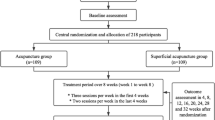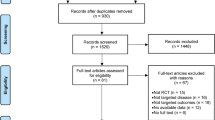Abstract
Objective
To observe the clinical efficacy of electroacupuncture (EA) combined with tuina for chronic tension-type headache (CTTH).
Methods
A total of 97 CTTH cases were randomly allocated into an observation group (n=52) and a control group (n=45). Patients in the observation group were treated with EA plus tuina based on pattern identification, whereas patients in the control group were treated with oral amitriptyline and oryzanol. Patients in both groups were treated for 8 weeks. A follow-up was conducted 3 months after the treatment. The intensity, duration, and frequency of the headache were recorded and compared before and after the treatment. Additionally, the patients’ psychological state and quality of life (QOL) were compared between the two groups.
Results
There were intra-group statistically significant differences in headache intensity score, headache duration, and headache frequency after the treatment and during the follow-up compared with those before the treatment (all P<0.05); and there were between-group statistically significant differences during the same time frame (all P<0.05). The Hamilton depression scale-17 items (HAMD-17) and Hamilton anxiety scale (HAMA) scores were significantly reduced in both groups after the treatment or during the follow-up (all P<0.01); and there were no between-group statistical significances during the same time frame (all P>0.05). The World Health Organization quality of life-BREF (WHOQOL-BREF) scores were significantly reduced in both groups after the treatment or during the follow-up (all P<0.05); and the scores in the observation group were significantly lower than those in the control group (all P<0.05) during the same time frame. The total effective rate was 88.0% in the observation group, versus 71.4% in the control group, showing a significant difference (P<0.05).
Conclusion
EA combined with tuina can significantly decrease the frequency of chronic tension-type headache, alleviate headache intensity, shorten headache duration, and improve the patients’ wellness. It is better than amitriptyline plus oryzanol.
摘要
目的
观察电针结合推拿辨证治疗慢性紧张性头痛的临床疗效。
方法
将纳入的97例慢性紧张性头痛患者采用随机数字表法随机分为两组, 观察组52例, 根据临床表现辨证分型采用电针及推拿治疗; 对照组45例, 采用口服阿米替林及谷维素治疗。两组均治疗8星期, 结束治疗3个月后随访。记录治疗前后及随访时两组患者的 头痛程度评分、头痛持续时间和头痛频率, 进行比较分析, 并比较两组心理健康状况及生存质量。
结果
治疗后和随访时, 在头痛程度评分、头痛持续时间和头痛发作频率方面, 两组均较本组治疗前明显改善(均P<0.05);且同 时段组间比较, 观察组均优于对照组(均P<0.05)。治疗后及随访时, 两组汉密尔顿抑郁量表(HAMD-17项)及汉密 尔顿焦虑量表(HAMA)评分均较本组治疗前明显降低(均P<0.01); 但同时段组间比较, 两组差异均无统计学意义 (均P>0.05)。治疗后及随访时, 两组世界卫生组织生活质量简表(WHOQOL-BREF)评分均较本组治疗前明显降低 (均P<0.05); 且同时段组间比较, 观察组均低于对照组(均P<0.05)。观察组总有效率为88.0%, 对照组为71.4%, 两 组差异有统计学意义(P<0.05)。
结论
电针结合推拿辨证治疗能明显减少慢性紧张性头痛患者的头痛发作次数,减轻头痛程度, 缩短头痛持续时间, 改善身心健康, 疗效优于阿米替林联合谷维素, 值得临床推广。
Similar content being viewed by others
References
Headache Classification Committee of the International Headache Society (IHS). The international classification of headache disorders, 3rd edition (beta version). Cephalalgia, 2013, 33(9): 629–808.
Bendtsen L, Jensen R. Tension-type headache: the most common, but also the most neglected headache disorder. Curr Opin Neurol, 2006, 19(3): 305–309.
Stovner Lj, Hagen K, Jensen R, Katsarava Z, Lipton R, Scher A, Steiner T, Zwart JA. The global burden of headache: a documentation of headache prevalence and disability worldwide. Cephalalgia, 2007, 27(3): 193–210.
Sun-Edelstein C, Mauskop A. Complementary and alternative approaches to the treatment of tension-type headache. Curr Pain Headache Rep, 2012, 16(6): 539–544.
Silberstein SD, Olesen J, Bousser MG, Diener HC, Dodick D, First M, Goadsby PJ, Göbel H, Lainez MJ, Lance JW, Lipton RB, Nappi G, Sakai F, Schoenen J, Steiner TJ; International Headache Society. The international classification of headache disorders, 2nd edition (ICHD-II)-revision of criteria for 8.2 medication-overuse headache. Cephalalgia, 2005, 25(6): 460–465.
Ministry of Health of the People’s Republic of China. Guiding Principles for Clinical Study of New Chinese Medicines. Beijing: China Medical Science Press, 2002: 105–109.
Shi XM. Science of Acupuncture and Moxibustion. Beijing: China Press of Traditional Chinese Medicine, 2007: 204.
Bendtsen L, Bigal ME, Cerbo R, Diener HC, Holroyd K, Lampl C, Mitsikostas DD, Steiner TJ, Tfelt-Hansen P; International Headache Society Clinical Trials Subcommittee. Guidelines for controlled trials of drugs in tension-type headache: second edition. Cephalalgia, 2010, 30(1): 1–16.
Loder E, Rizzoli P. Tension-type headache. BMJ, 2008, 336(7635): 88–92.
Mao ZF, Wang JR. Electroacupuncture combined with massage for 71 cases with tension headache. Zhejiang Zhongxiyi Jiehe Zazhi, 2006, 16(1): 17–19.
Xu K, Chen XL, Luo RH. Effects of electroacupuncture at Sishengcong (EX-HN1) on 5-hydroxytryptamine and dopamine in serum of depression patients. Xin Zhongyi, 2011, 43(4): 87–89.
Wu YY, Zhao XY, Jiang YL, Fang JQ. Experimental observation and central 5-HT mechanism on dual analgesia and anti-depression effect of electroacupuncture with different frequencies on rats. Zhejiang Zhongyiyao Daxue Xuebao, 2014, 38(8): 939–944.
Yuan Y, Wen YJ, Wang Y, Zheng FJ, Zhou K, Li YK. Clinical study of scalp acupuncture treatment for migraine without aura. Shanghai Zhenjiu Zazhi, 2016, 35(1): 14–18.
Zhang JH, Zhang J. Efficacy comparison of treatment by electroacupuncture of migraine and changes of serum MMP-9. Zhongguo Difangbing Fangzhi Zazhi, 2014, 29(2): 141–142.
Liu XT, Xu LL, Ma TM. Study on acupuncture treatment of migraine by randomized parallel control trial. Shiyong Zhongyi Neike Zazhi, 2015, 29(4): 134–136
Guo Q, Hua Y, Wang HQ, Li Y, Ji Q. Therapeutic effect observation on combining electroacupuncture and tuina for migraine. J Acupunct Tuina Sci, 2014, 12(3): 174–179.
Yu DF. Tuina Science. Shanghai: Shanghai Scientific and Technical Publishers, 1985: 6–7.
Tan T, Wang JG, Sun Q, Shi YS. Vessel-freeing and qiregulating tuina therapy for tension headache: a clinical study of 150 cases. Zhongyi Zazhi, 2007, 48(2): 143–146.
Author information
Authors and Affiliations
Corresponding author
Rights and permissions
About this article
Cite this article
Cai, Xb., Yang, Zx., Li, Y. et al. Clinical observation on electroacupuncture plus tuina for chronic tension-type headache. J. Acupunct. Tuina. Sci. 15, 120–125 (2017). https://doi.org/10.1007/s11726-017-0987-x
Received:
Accepted:
Published:
Issue Date:
DOI: https://doi.org/10.1007/s11726-017-0987-x




